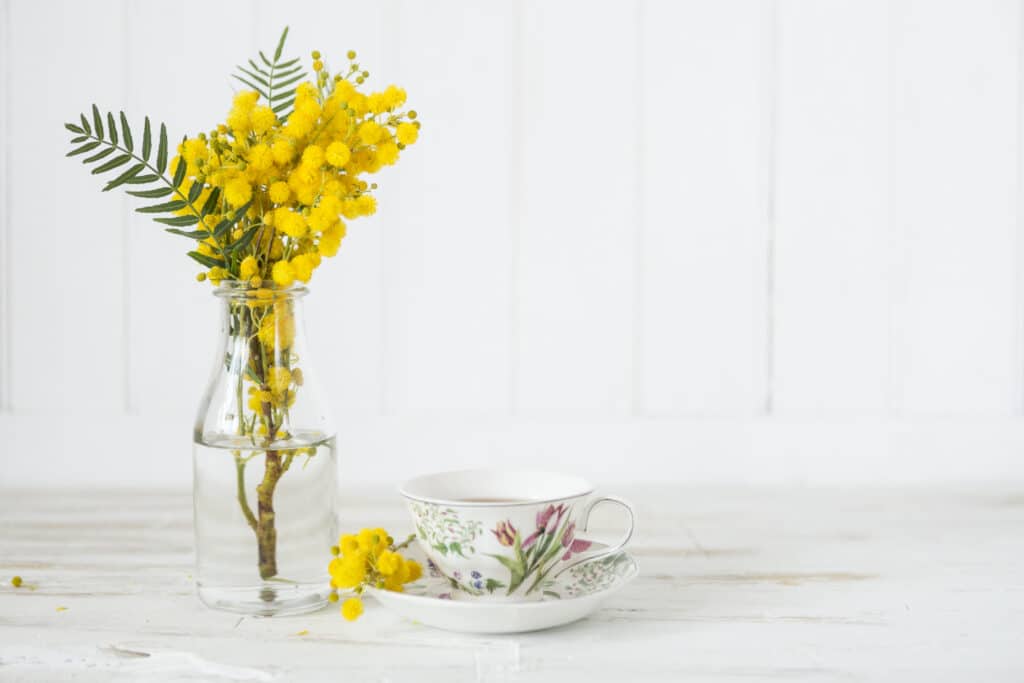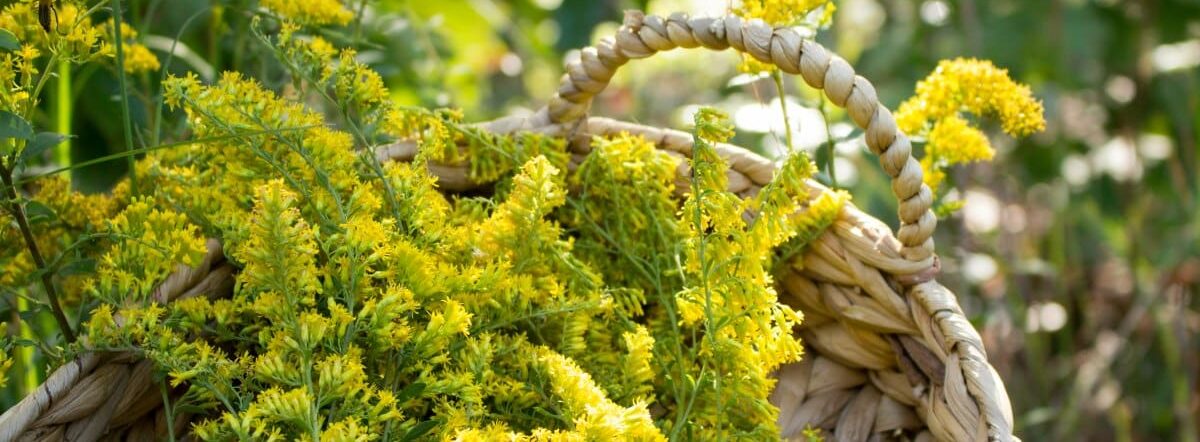Sweet And Savory Goldenrod Recipes
Goldenrod is a plant with more than 100 kinds in North America. It has hairy stems and green leaves. The yellow flowers can make food taste better or dye cloth pretty colors.
People use goldenrod because it helps with allergies, makes peeing easier, and fights infections.
There are sweet ways to enjoy goldenrod, like teas and treats, as well as savory ones that include oils for cooking and herbs for health. This plant makes special lotions, soaps, and bars that could help one’s skin or soothe pains like arthritis.
But be careful — while goldenrod is good for many people, it can also cause rashes for some folks, and it is not good for sheep. Ready to find out how this sunny flower can spice up your meals and keep you feeling great? Let’s learn about making amazing goldenrod dishes!
Key Takeaways

-
- Goldenrod is a plant that blooms yellow and helps with health problems like colds, flu, and skin wounds. It can also soothe muscle pain and help pee flow.
-
- You can make tasty things with goldenrod, like tea, jelly, or oil for salads. This plant adds a special flavor to food and drinks.
-
- The bright flowers of goldenrod can dye cloth yellow or gold naturally. People use this instead of fake dyes.
What is Goldenrod and its Characteristics
Goldenrod is a striking plant that stands out in fields and along roadsides. Its bright yellow flowers form tall spikes and wave in the late summer breeze. Many people think goldenrod causes allergies, but it’s often confused with ragweed, which blooms at the same time.
This hardy plant has much to offer beyond its beauty. Herbalists use goldenrods to make remedies to ease colds and heal wounds. They have tough stems with thin leaves running up their length.
They may feel slightly rough due to tiny hairs when you touch them.
Goldenrods love sunlight and grow well in open areas across North America. There are many types of goldenrod, each with similar sunny flowers that bees and butterflies visit for nectar.
Because of their vibrant color, these plants can also be used in cooking or as fabric dye.
Benefits and Uses of Goldenrod
Additionally, goldenrod can be foraged and used in culinary creations like tinctures, teas, oils, salves, and even soaps. Its vibrant yellow flowers also make it an excellent natural dyeing agent.
With its wide range of applications, goldenrod is a valuable addition to any health-conscious individual’s repertoire.
Medicinal Benefits
It’s also full of things that protect your body from harm—much more than green tea! People use it to make their bladder healthy and fight swelling in the body.
This plant is not just pretty; it’s powerful medicine. Goldenrod can stop allergies in their tracks around ragweed season. If you have arthritis or muscle pain, goldenrod might also ease that sore feeling.
Remember its strong effects on kidney stones and bladder infections? Many folks trust this bright flower to heal them inside out!
Culinary Uses
You can enjoy goldenrod in many tasty ways. People use the flowers and leaves to make a sweet tea that’s good for you. If you like cooking, try adding fresh goldenrod to your meals.
It brings a special flavor to your food and may cheer you up in the cold winter.
Goldenrod works well in both sweet and savory dishes. For a treat, mix dried goldenrod into jelly or stir it into hot sauce for extra taste. Want something new? Use the flowers to infuse oil, then drizzle it over your favorite salad or toast for an herbal kick.
With its sunny flavor, goldenrod makes kitchen time fun and healthy!
Dyeing with Goldenrod
Goldenrod flowers can be used to dye fabric into beautiful yellow and gold colors. Dyeing with goldenrod is easy, resulting in a delightful yellow color. This natural dye can be created for natural fibers like cotton or wool.
It’s an eco-friendly alternative to synthetic dyes, perfect for those interested in sustainable living and avoiding harmful chemicals.
The goldenrod plant offers health benefits and artistic possibilities through its natural dyeing properties. Experimenting with this method may open a new world of creative expression while connecting you more deeply with the environment.
Sweet Goldenrod Recipes
Indulge in the natural sweetness of goldenrod with these delicious and healthful recipes. From soothing tinctures to refreshing teas, a world of culinary possibilities is waiting for you to explore.
So buckle up and get ready to dive into the flavors and benefits of this versatile herb!
Goldenrod Tincture
Goldenrod tincture is a versatile herbal remedy known for its medicinal and culinary uses. This natural remedy offers various benefits, including respiratory support, urinary tract health, anti-inflammatory properties, and wound healing capabilities. Both gray and European goldenrod can be utilized to create this beneficial tincture.
- Respiratory Support: Goldenrod tincture can aid in relieving symptoms associated with respiratory issues such as allergies, sinus congestion, and sore throat.
- Urinary Tract Health: The tincture may be a natural remedy for urinary tract infections (UTIs) due to its diuretic and antimicrobial properties.
- Anti-Inflammatory Properties: Goldenrod tincture acts as an effective anti-inflammatory agent, potentially reducing inflammation in the body.
- Wound Healing: Applying goldenrod tincture on wounds may promote faster healing and prevent infection.
- Culinary Uses: Besides its medicinal benefits, goldenrod tincture can be added to culinary creations, enhancing flavors and providing potential nutritional value.
Goldenrod Tea
Goldenrod tea is a beneficial herbal drink that offers various health advantages. It contains significant antioxidants and is considered to have medicinal properties.
-
- Harvest fresh goldenrod flowers during their full bloom.
-
- Add a spoonful of fresh goldenrod flowers to a mason jar.
-
- Pour hot, but not boiling, water over the flowers in the jar.
-
- Let it steep for approximately 15 – 20 minutes before straining through cheesecloth.
-
- Goldenrod tea has a sweet, “anise-like” scent and can be sweetened with honey if desired.
Savory Goldenrod Recipes

Get ready to elevate your culinary skills with these savory goldenrod recipes. From infused oils and salves to handmade soaps and lotion bars, a world of possibilities awaits you.
So buckle up, and let’s dive into the wonderful world of savory goldenrod creations!
Goldenrod-Infused Oil
Goldenrod-infused oil has been historically used as a remedy for aches, strains, and sprains. It also serves as a potent ingredient to salve for skincare and healing purposes.
-
- Historical Healing: When applied to the skin, the oil’s historical use as a diuretic and for wound healing makes it an essential addition to any natural remedy cabinet.
-
- Versatile Applications: It can be combined with beeswax to create a balm or utilized directly from the container, catering to various needs and preferences.
-
- Enhancing Medicinal Benefits: Infusing the oil with additional herbs or ingredients further boosts its medicinal and culinary properties, offering a customizable approach to health and wellness.
Goldenrod Salve
Goldenrod salve, a topical application made from goldenrod blooms and leaves, is renowned for its potential medicinal benefits. This salve has been linked to dermatitis and is toxic to sheep, so caution should be exercised.
- Harvest fresh goldenrod blooms and leaves during the flowering season.
- Dry the harvested plant material thoroughly to remove any moisture.
- Infuse the dried goldenrod in a carrier oil such as olive or sunflower for several weeks to extract its beneficial properties.
- Strain the infused oil to remove the plant material.
- Melt beeswax in a saucepan and add the infused oil to create a thick consistency.
- Pour the mixture into containers and allow it to cool and solidify.
Goldenrod Soap
Goldenrod soap is a delightful way to benefit from the properties of goldenrod. This soap features goldenrod-infused oil and tea and can have a design imprint using a fondant mat. With its natural ingredients, it can help heal and soothe the skin.
-
- Infused Oil: Goldenrod soap includes goldenrod-infused oil, known for its medicinal uses. This oil helps provide nourishment to the skin and offers potential healing properties.
-
- Goldenrod Tea: The soap also incorporates goldenrod tea, adding an extra layer of herbal goodness to your skincare routine. Goldenrod tea has been used for its potential health benefits.
-
- Design Imprint: A special feature of goldenrod soap is that it can have a design imprint using a fondant mat. This allows for creative and unique designs on each bar of soap.
-
- Cold Process Recipe: A popular method for making goldenrod soap is through the cold process, where honey is added to enhance the natural benefits of this herbal product.
Goldenrod Lotion Bars
Goldenrod lotion bars are rich in medicinal properties and delightful aromas, potentially benefiting conditions like arthritis.
-
- Medicinal Benefits: Goldenrod lotion bars contain anti-inflammatory and pain-relieving properties, making them suitable for easing joint pain and muscle discomfort.
-
- Aromatic Qualities: The bars emanate a sweet, earthy aroma that can promote relaxation and stress relief when used as part of a skincare routine.
-
- Skincare Integration: When used regularly, goldenrod lotion bars can improve overall skin health by moisturizing and soothing dry or irritated skin.
-
- Practical Application: These lotion bars offer a convenient and mess-free way of applying the beneficial properties of goldenrod to the skin, promoting wellness with ease.
FAQs
1. What is goldenrod, and can I eat it?
Goldenrod, also known as Solidago, is an edible and medicinal plant. You can use goldenrod to make herbal recipes like teas or savory dishes.
2. Are people allergic to goldenrod?
No, it’s often thought that goldenrod causes allergies because it blooms when ragweed does. But actually, the pollen from ragweed is the cause of allergy symptoms, not goldenrod.
3. Can you tell me how to make a goldenrod infusion?
Sure! To make a goldenrod infusion or tea, add the leaves or flowers to hot water, let them sit until the flavor comes out, then take one cup and enjoy!
4. What are some sweet recipes that include goldenrod?
For a unique taste, you can make cookies by mixing in finely chopped goldenrod flowers.
5. Is there a savory recipe using goldenrods I could try?
Yes! You might like making a white sauce with added dried Goldenrods spices stirred into milk and cooked until thickened into your roux.
6. How do I store my homemade recipes made with Goldenrods so they stay fresh longer?
For things like oils or infusions with Goldenrods, cap the jar tightly and keep them in a cool place away from light – like your pantry or fridge.

